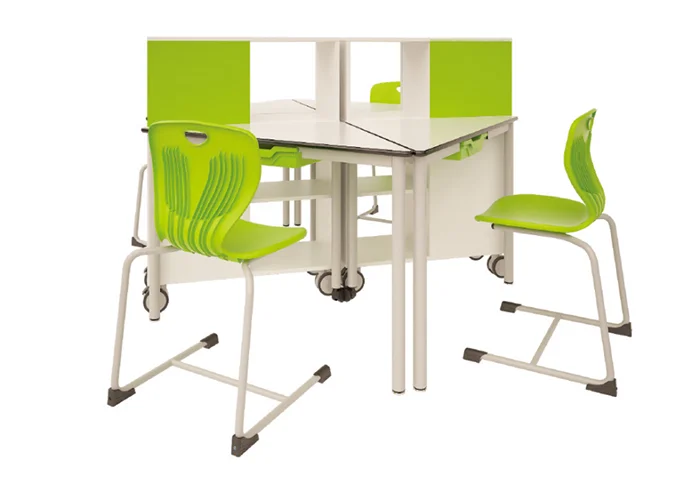Creating Inclusive Learning Spaces with Collaborative Student Desks: A Comprehensive Guide
多行文本内容元素
富文本内容绑定数据后可解析HTML语言内容
Release time:
Jul 26,2025
Summary:Creating Inclusive Learning Spaces with Collaborative Student Desks
Table of Contents
1. Understanding Inclusive Learning Environments
2. The Importance of Collaborative Student Desks
2.1 Benefits for Students
2.2 Enhancing Teacher Interaction
3. Key Features of Collaborative Desks
3.1 Flexibility and Modularity
3.2 Ergonomic Design for Comfort
4. Designing an Inclusive Classroom Layout
4.1 Arrang
Creating Inclusive Learning Spaces with Collaborative Student Desks
Table of Contents
1. Understanding Inclusive Learning Environments
2. The Importance of Collaborative Student Desks
2.1 Benefits for Students
2.2 Enhancing Teacher Interaction
3. Key Features of Collaborative Desks
3.1 Flexibility and Modularity
3.2 Ergonomic Design for Comfort
4. Designing an Inclusive Classroom Layout
4.1 Arranging Collaborative Desks
4.2 Creating Zones for Different Activities
5. Best Practices for Implementing Collaborative Desks
5.1 Involving Students in the Process
5.2 Continuous Feedback and Improvement
6. Overcoming Challenges in Implementation
7. Future Trends in Collaborative Learning Spaces
8. Frequently Asked Questions (FAQs)
9. Conclusion
1. Understanding Inclusive Learning Environments
Inclusive learning environments are essential for fostering student engagement, participation, and success in education. These spaces are designed to accommodate diverse learning needs and styles, ensuring every student, regardless of background or ability, can thrive. By creating an atmosphere where all learners feel valued and supported, educators can enhance collaboration, improve social interaction, and promote academic achievement.
2. The Importance of Collaborative Student Desks
Collaborative student desks serve as the cornerstone for developing inclusive learning spaces. They facilitate group work, encourage communication, and help students build valuable social skills. Here, we delve into the significant benefits of implementing collaborative desks in educational settings.
2.1 Benefits for Students
The adoption of collaborative student desks allows learners to engage more effectively with their peers. By promoting teamwork and cooperation, these desks help students develop critical thinking skills and foster a sense of community. Furthermore, when students work together, they can share diverse perspectives, enhancing their understanding of various subjects.
2.2 Enhancing Teacher Interaction
Collaborative student desks not only benefit students but also improve teacher interactions. When educators can easily circulate among groups, they can provide personalized support, encourage dialogue, and facilitate active learning. This dynamic interaction promotes a more engaging and impactful educational experience for all participants.
3. Key Features of Collaborative Desks
To create effective collaborative learning environments, it's crucial to select desks that embody specific features designed to facilitate collaboration. Here are two key aspects to consider when choosing collaborative student desks.
3.1 Flexibility and Modularity
Collaborative desks should be designed with flexibility in mind. Modularity allows educators to rearrange desks as needed based on the learning activities or the group dynamics. This adaptability is essential for accommodating different teaching methodologies and ensuring that the learning environment remains dynamic.
3.2 Ergonomic Design for Comfort
An ergonomic design not only enhances comfort but also improves focus and productivity. Desks should be adjustable to accommodate various heights, ensuring that students of all sizes can work comfortably. Additionally, features such as rounded edges and sturdy materials contribute to a safe and inviting learning space.
4. Designing an Inclusive Classroom Layout
An inclusive classroom layout is vital for optimizing the use of collaborative desks. Thoughtful design can significantly impact student engagement and interaction. Here, we explore two essential aspects of classroom design.
4.1 Arranging Collaborative Desks
When arranging collaborative desks, consider the size of the classroom and the number of students. Desks can be configured in clusters, circles, or rows to encourage interaction. Additionally, ensure that there is enough space for movement, allowing students and teachers to navigate the classroom easily.
4.2 Creating Zones for Different Activities
Dividing the classroom into zones can enhance learning by providing areas for different types of activities. For example, a zone for group work can be equipped with collaborative desks, while a reading corner can offer a quieter environment for individual study. This variety caters to diverse learning preferences and encourages students to engage in multiple learning modalities.
5. Best Practices for Implementing Collaborative Desks
To ensure the successful implementation of collaborative desks, consider the following practices that promote inclusivity and engagement.
5.1 Involving Students in the Process
Involving students in the selection and arrangement of collaborative desks empowers them and fosters a sense of ownership in their learning environment. Gathering feedback from students on their preferences and needs can lead to a more effective classroom layout and enhance their overall educational experience.
5.2 Continuous Feedback and Improvement
Establishing a routine for gathering feedback from both students and teachers can help identify areas for improvement within the collaborative learning environment. Regular assessments of the effectiveness of the desk arrangements and classroom layout can lead to ongoing enhancements that benefit all learners.
6. Overcoming Challenges in Implementation
Implementing collaborative student desks may come with challenges. Some educators may encounter resistance from students who are accustomed to traditional desk arrangements, while others may struggle with space constraints. To overcome these challenges, educators can:
- Provide professional development opportunities focused on collaborative teaching strategies.
- Encourage open dialogue among students about their experiences with collaborative desks.
- Utilize creative solutions, such as multi-functional furniture, to maximize available space.
7. Future Trends in Collaborative Learning Spaces
As educational practices evolve, so too do collaborative learning environments. Future trends may include:
- Increased use of technology, such as interactive displays and collaborative software, to enhance engagement.
- Greater emphasis on sustainability in furniture design, promoting eco-friendly materials and practices.
- Innovative classroom designs that prioritize flexibility and adaptability to accommodate various teaching styles.
8. Frequently Asked Questions (FAQs)
1. What are collaborative student desks?
Collaborative student desks are multifunctional furniture pieces designed to facilitate group work and encourage peer interaction among students.
2. How do collaborative desks benefit students?
They enhance teamwork, improve communication skills, and create a sense of belonging, ultimately leading to better academic performance.
3. What features should I look for in collaborative desks?
Look for desks that are flexible, modular, and ergonomically designed to support various learning activities and student needs.
4. How can I arrange collaborative desks in my classroom?
Consider arranging desks in clusters or circles, ensuring there is sufficient space for movement and interaction among students.
5. How can I gather feedback on the effectiveness of collaborative desks?
Establish regular feedback sessions with both students and teachers to discuss their experiences and any challenges they may face.
9. Conclusion
Creating inclusive learning spaces with collaborative student desks is essential for fostering a supportive and engaging educational environment. By understanding the importance of these desks, implementing best practices, and embracing future trends, educators can ensure that every student feels valued and empowered to reach their full potential. Through thoughtful design and continuous improvement, we can create classrooms that not only accommodate diverse learning styles but also inspire collaboration and innovation among students.


